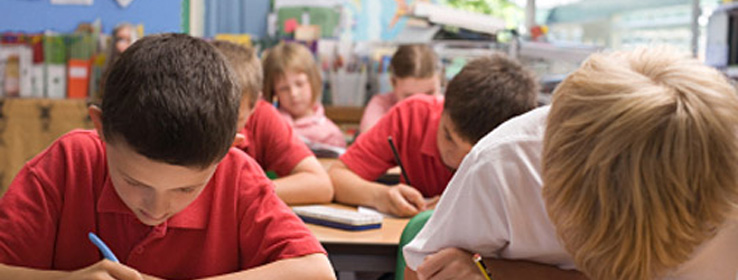If children are the hope of the future, why is so little emphasis placed on the spaces in which they learn?
A positive, nurturing, educational environment and atmosphere are instrumental in preparing children to function and thrive in society. Color and light are essential components of children's workspaces and have a powerful impact on their productivity. Knowing how many aspects of a child's well-being are out of most school administrators' control, it seems logical to me that they'd place an emphasis on improving those elements within their influence. So why color and lighting in schools are left as afterthoughts – if considered at all – is beyond me.
In my neighborhood, parents of children attending our local elementary school have been working like crazy to raise funds for a new classroom building. The energy focused on this project has been phenomenal. Inspired by the community spirit, I offered my color consulting services to select a palette for the interior. Much to my dismay, I learned that our public school district offers its schools a selection of just five interior paint colors ranging from white to putty to gray. All that effort to improve the learning environment for children, yet no thought is given to the vital component of color.
Color design, when approached from a functional standpoint rather than aesthetics, can prevent eyestrain and increase attention span and productivity. Monotone, poorly designed and poorly lit classroom conditions can cause irritability and inattentiveness and exacerbate behavioral problems.1 In addition to visual ergonomics, age groups and their developmental stages have to be considered. A kindergarten student processes information very differently than a sixth grader.
Just as schools are taking a more holistic approach to learning by nurturing many learning styles and experiences, so too should this theory be extended to the physical school environment, one that enhances student learning. Spaces dominated by gray, beige and a variety of whites simply don't cut it.
Psychological color studies have shown that sociable, energetic preschool and elementary grade-level students react favorably to the stimulation of warm colors such as yellow-orange and peach, whereas older children in middle school and above function better in cooler hues, enabling them to concentrate more effectively.2
On the other hand, overstimulation is just as bad as understimulation. One classic example of well-intentioned but misplaced color design is the quintessential grade school classroom. Visual noise is the unfortunate result of a mishmash of posters, charts and artwork displayed against bright, primary-colored construction paper, surrounded by decorative borders.3 When was it determined that children must have such a saturated environment, or that they can't appreciate the nuances of more complex colors? I suppose much of this is teachers' reaction to the sterile surroundings in which they're expected to educate.
Lighting is another essential component that goes hand in hand with color. I have a major gripe with the horrible lighting conditions in most classrooms and school spaces – flickering, harsh fluorescent tubes that cast cold, glaring light. A fuller spectrum of light, closer to that produced by daylight, is much more conducive to productivity and a healthy learning environment. Studies have shown that classrooms lit with natural light or full-spectrum lighting, painted appropriate colors, and devoid of visual noise have wonderful results with students.4 There is less off-task behavior, disruptiveness and aggression and better academic performance and attitude.
Children have the right to be educated in carefully planned, well-designed, ergonomic spaces that cater to their learning needs. Educated color decisions play a large role in this and can make a world of difference.
1 Color, Environment and the Human Response by Frank H. Mahnke. (Wiley, 1996).
2 Some Aspects of an Ideal Classroom: Color, Carpet, Light and Furniture by Edward B, Nuhfer. isu.edu.
3 Lighting the Learning Environment by Randall Fielding. DesignShare.com
4 Color & Human Response: Aspects of Light and Color Bearing on the Reactions of Living Things and the Welfare of Human Beings by Faber Birren (Wiley, 1984).





